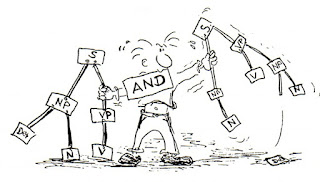 |
| ello.uos.de |
- be obligatory; they cannot normally be omitted. "The white _ with a stripy tail is ungrammatical;
- be able to stand for the phrase as a whole, wherever the phrase occurs. Because cat is the head of the whole phrase the white cat with a stripy tail and cat is co-referential with Henry, Henry (or just he) can replace the whole phrase (e.g. Henry pounced; the white cat with a stripy tail pounced; he pounced). In linguistic analysis, a phrase can therefore consist of just one word;
- determine the word class of the entire phrase. The word class of the head in "The white _ with a stripy tail determines and gives the name to the whole group of words.
Heads dominate the words they are head of: they determine many of the grammatical properties of the phrase. For example, heads provide slots for the words they enter into morpho-syntactic relations with (with in; and they frequently specify the grammatical properties required of the elements they select, i.e. their dependents. For example, because sparrows is plural, those is plural, too. Heads thus often require their dependents to agree with some or all of their grammatical features, overtly or covertly. Whether the agreement is explicitly morphologically marked or not largely depends on how much agreement morphology a given language has. English has little, so we only get the two types of overt agreement discussed in the previous chapter: the agreement in number between the determiner and the noun already illustrated with those sparrows, and agreement in person and number between the subject and present-tense verbs, as in Herry pounces.
Heads also largely determine the relation between the phrase they are head of, and the 'world' beyond the phrase, i.e. the sentence they are embedded in. In other words, heads determine the external relations a phrase can enter into: for example, with determines that a stripy tail can occur with cat, as in ... cat with a stripy tail. Heads do for phrases what periscopes do for submarines: they keep contract with the outside world.
Despite their importance, the concept of head is quite controversial in syntax. We know that heads exist, but there is still debate on whether all phrases have heads, whether all heads behave in the same way, and whether heads are always necessary. Let's look at some examples of head-dependent relationships.
Source English Words and Sentences - Eva Duran Eppler and Gabriel Ozón - Cambridge University Press
Source English Words and Sentences - Eva Duran Eppler and Gabriel Ozón - Cambridge University Press

Belum ada tanggapan untuk "What are 'heads' in syntax?"
Posting Komentar